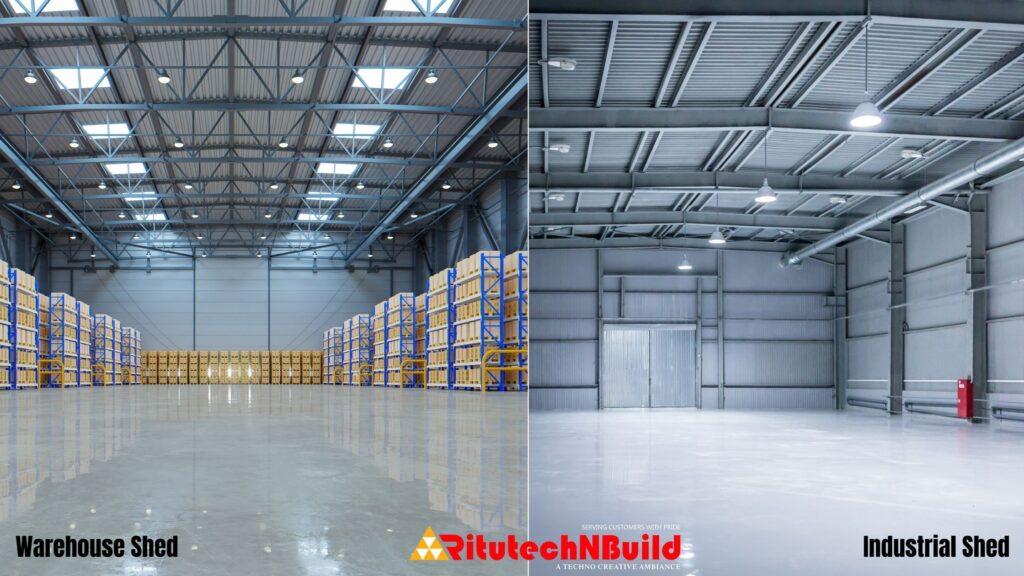A warehouse and an industrial shed are both large structures made by pre-engineered building methods. Both are excellent examples of using prefabrication construction technology. Moreover, these carry high value from a commercial perspective and real estate. While both these buildings seem similar structurally from the outside, they have many differences. The warehouse and Industrial Shed Manufacturers adopt different techniques, designs and approaches in making these buildings because each of them has different sets of requirements. At Ritu Tech n Build, we provide solutions for building warehouses as well as industrial sheds. We have covered many building projects and have received high positive feedback for executing the project in a fast construction time and delivering excellent results. In this blog, we will delve into the key differences between a warehouse and an industrial shed.
Understanding Differences Between Warehouse and Industrial Shed
To understand the differences between the two, we can explore their purpose, layout, structural requirements, and applications.
Definition
Warehouse Shed: These are large buildings with a single-storey structure and wide interiors used for goods storage and inventory management. Warehouse sheds are made using steel or composite of reinforced concrete and steel. The entrances for these sheds are wide enough for heavy transport vehicles to enter and exit the loading docks.
Industrial Shed: These are hubs of various industrial activities where the making of parts of goods, their assembly and distribution take place. It contains machines, supply chain and the layout is designed for efficient production. Using pre-fabrication of steel and modular construction techniques, the industrial shed structure is finished in a fast time.
Purpose
Warehouse Shed: The purpose of the warehouse is to store finished goods, raw materials and provide sufficient protective shelter for inventory management and logistics. These are essential parts of the product supply line. Storing, receiving and distributing to various places is managed under the warehouse sheds.
Industrial Shed: These are constructed to provide shelter to manufacturing, assembling and processing goods in various sectors. The raw material sourcing, fabrication, assembly, quality tests, and various industrial processes are facilitated under these sheds.
Layout
Warehouse Shed: The interiors of warehouses feature racking systems that use vertical spacing for efficient storage. Docks and shelving systems are made for access to goods. The interiors have large open spaces for sufficiently accommodating the racking systems and ventilation systems.
Industrial Shed: The layout of the industrial shed features machinery and spaces for easy commute of operators and the entire workforce within the shed. The infrastructure of these sheds accommodates strategically placed machines, storage zones, supply rails and beams, and HVAC systems.
Structural Requirements
Warehouse Shed: To keep the items in a controlled environment, these may have insulated panels and HVAC systems to keep the humidity and temperature under control. Minimal number of columns, and open space with forklifts are some of the standard structural requirements in warehouses.
Industrial Shed: The floor of industrial sheds needs to be strong and able to bear heavy machinery loads without cracking. Moreover, cranes and beams may be attached to the ceiling as per the demand of production. To keep the interiors comfortable and machines safe from moisture, thermal stability systems are installed. Fumes and waste are disposed of using special treatment facilities.
Applications
Warehouse Shed: The key applications of warehouses are storage and distribution. The examples are logistics hubs, processed food storage centres, agricultural stock yards, automotive part storage, bulk goods facilities, e-commerce storage units, etc. Almost every manufacturing industry uses warehouses for its goods.
Industrial Shed: The Main applications of industrial sheds are small to large factory units, workshops, various manufacturing plants, and assembly facilities.
Conclusion
To conclude, warehouse sheds are those with shelving units for storage of various goods, while industrial sheds are the ones where manufacturing, assembly and production of goods take place. While both have commercial importance, they have distinct purposes. Besides, the layout of the warehouse is used to install large racks, while industrial sheds have machinery. If you need to consult about the construction of any of these sheds, our experts at Ritu Tech N Build can provide you with comprehensive guidance.



